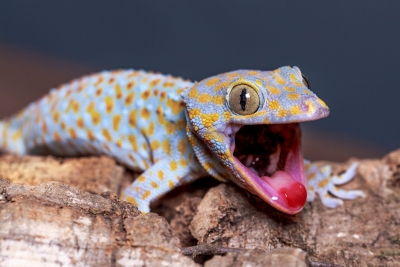
Geckos are also able to shed their tails if a predator grabs them.
Most geckos are nocturnal, which means they are active at night, but day geckos are active during the day and nibble on insects, fruits, and flower nectar. Most geckos make noises such as chirping, barking, and clicking when they are defending their territory or attracting a mate.
Nocturnal species have excellent night vision; their color vision in low light is 350 times more sensitive than human color vision. The nocturnal geckos evolved from diurnal species, which had lost the eye rods. The gecko eye, therefore, modified its cones that increased in size into different types, both single and double. Three different photopigments have been retained and are sensitive to UV, blue, and green. They also use a multifocal optical system that allows them to generate a sharp image for at least two different depths. While most gecko species are nocturnal, some species are diurnal and active during the day, which has evolved multiple times independently.
Like most lizards, geckos can lose their tails in defense, a process called autotomy. Many species are well known for their specialised toe pads that enable them to climb smooth and vertical surfaces, and even cross indoor ceilings with ease. Geckos are well known to people who live in warm regions of the world, where several species make their home inside human habitations. These (for example the house gecko) become part of the indoor menagerie and are often welcomed, as they feed on insects, including moths and mosquitoes. Unlike most lizards, geckos are usually nocturnal.
Picture Credit : Google



